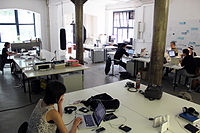
Photo from wikipedia
Purpose The purpose of this paper is to take an explanatory role and analyse the development of workspace ambiences in coworking spaces which optimise the chance of interactivity between individual… Click to show full abstract
Purpose The purpose of this paper is to take an explanatory role and analyse the development of workspace ambiences in coworking spaces which optimise the chance of interactivity between individual users and leading towards cooperation. The paper thus offers a discussion on how the ambience that is tailored to a particular coworking space enhances the possibility of collaboration between two or more users of a selected workspace. Design/methodology/approach Ethnographically guided observations of six coworking spaces and qualitative interviews with their managers were used to gain an understanding of the workspace ambiences in coworking spaces. As direct measurement of the frequency of collaboration would be logistically profound, this paper rather explores the conditions for spontaneous or moderated interactivity between workspace users, which may be regulated by the creation of an optimal coworking space ambience. Findings The following paper defines the coworking space ambience as the look and the feel of a work environment which can arouse certain moods towards a particular place and its users. Coworking spaces may impose various approaches that not only attract potential workspace users and form initial ties between them but also produce a certain ambience that leads to collaborative action between users. The factors of spatial design need to be adapted, and engagement strategies need to be constructed to maximise the preferential output. The research behind the following paper concludes that the factors of spatial comfortability are an essential predisposition for workspace users to engage in cooperation with each other. Various mechanisms are needed to customise these engagements into cooperative action. Originality/value While the outcomes of sharing these environments have been periodically explored, no attempts have been made to investigate how coworking ambience is being created and implemented to optimise collaborative efforts of individuals who are sharing the workspace. For that reason, the audience of this paper should not only be limited to academics but may also be suitable for managers and office-space operators seeking to understand dynamics of collaboration within new types of shared office spaces.
Journal Title: Journal of Corporate Real Estate
Year Published: 2019
Link to full text (if available)
Share on Social Media: Sign Up to like & get
recommendations!